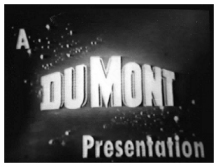Metropolitan News-Enterprise
Thursday, October 3,
2002
Page 18
REMINISCING (Column)
Channel 2, Your Du Mont Station
By ROGER M. GRACE
Channel 2 has for so
many years been the CBS “owned and operated” station in Los Angeles that one might suppose
it was the Columbia Broadcasting System that launched it. Not so.
In fact, it was once an affiliate of another network, Du Mont.
Back then, its call letters were KTSL.
In the Radio and Television Life issue of Oct. 17,
1948, columnist Jane Pelgram reported:
“The Don Lee Television Station KTSL (W6XAO) has
joined the Dumont Television Network, and as a result is presenting, each
Sunday night at 7:00, film of ‘The Original Amateur Hour.’ Old Gold
sponsors the video film at KTSL, as well as the live radio hour Wednesday night
at 7:30, KECA.”
When KTSL aligned itself with Du Mont, it became an affiliate of
that network, but was was not “hooked up” with it, in the physical sense.
Coast-to-coast hook-ups (by cable or microwave relays) were yet to come. With
TV shows then originating on the East Coast, no Du Mont shows were seen here
live.
Nonetheless, the new arrangement provided uplifted
potential for both parties. Du Mont needed an L.A. outlet and KTSL needed Du Mont.
Channel 2’s programming, once ambitious and
innovative, was sagging. By October 1947, KTSL was broadcasting only one show
that was a credit to the station, “Queen for a Day” (later to become a network
mainstay). Other than that show, aired at 10
a.m. Tuesday through Friday, KTSL
presented only wrestling, boxing, and what was billed in a TV log as “Test
Pattern With Incidental Music.”
Retrogression for KTSL was understandable. The station
had been led, as had the Mutual-Don Lee radio network, by Thomas S.
Lee, son of founder Don Lee. “Tommy” Lee reportedly developed brain cancer, and
was adjudged mentally incompetent in September, 1948. (On Jan. 13, 1950, he
jumped to his death from the 12th floor of the Wiltern Building.)
So it was that KTSL became an affiliate of the “fourth network.”
Or was Du Mont — generally misspelled DuMont — actually the Number Three
network when Channel 2 joined it in 1948?
Clearly, NBC was in front; CBS was second. These were
long established radio networks. Each network had its radio affiliates, many of
which launched TV stations which became the network’s television affilates.
Vying for status as the third network were Du Mont and ABC.
Du Mont’s network
was born in 1946 when two of its East Coast  television stations, WABD in New York and
WTTG in Washington, were linked. In the two years that followed, Du Mont amassed
more outlets than ABC, although several were on the UHF band which most sets
were not equipped to receive. Nonetheless, in its heyday, Du Mont owned
three stations and had 175 others as affiliates.
television stations, WABD in New York and
WTTG in Washington, were linked. In the two years that followed, Du Mont amassed
more outlets than ABC, although several were on the UHF band which most sets
were not equipped to receive. Nonetheless, in its heyday, Du Mont owned
three stations and had 175 others as affiliates.
The American Broadcasting Company was, like Du Mont, a
relative newcomer to broadcasting. In 1941, the FCC ordered the National
Broadcasting Company to divest itself of one of its two radio networks, NBC Red
or NBC Blue. That order was upheld in 1943 by the U.S. Supreme Court. A candymaker,
Edward Noble, bought the Blue Network, and it became ABC.
As of the late 1940s, it was anyone’s guess whether
either of these fledgling networks — or, indeed, whether CBS or NBC — would
triumph in the seemingly up-and-coming (but perhaps never-to-succeed) medium of
television.
Shows on the Du Mont network included “Arthur Murray Party,”
“You Asked for It,” “Adventures of Ellery Queen,” “Twenty Questions,” “Charade
Quiz,” “Spin the Picture,” and “Captian Video.” Unfortunately, none of those
shows made it to KTSL.
However, the station did air, in addition to the
“Original Amateur Hour,” these Du Mont shows:
“Cavalcade of Stars” (a variety show which made Jackie
Gleason a star and introduced the “Honeymooners” skits); “Cavalcade of Bands”
(each week featuring a different top-name band); “Morey Amsterdam Show” (a
comedy/variety series); “Plainclothesman” (an innovative detective show seen
through the eyes of the principal character); “Famous Jury Trials” (courtroom
dramas); “Hands of Mystery” (murder/suspense plays); “Rocky King, Inside
Detective” (a crime show); “Once Upon a Tune” (a one-hour musical, generally a
parody); and “Manhattan Spotlight” (15-minute interviews from the New York
station).
To an extent, the association with Du Mont re-energized the
station. Too, new local shows were being aired, such as “What’s the Name of
That Song?” “Hollywood Road to Fame,” and “Date With a Dream.” Peter Potter,
the disc jockey later to “preside” over “Juke Box Jury,” was the station’s
late-night personality. Former NBC-Red radio commentator Fleetwood Lawton
delivered the news report and was nominated for a 1950 Emmy, then a local
award, losing to “KTLA Newsreel.”
 television stations, WABD in New York and
WTTG in Washington, were linked. In the two years that followed, Du Mont amassed
more outlets than ABC, although several were on the UHF band which most sets
were not equipped to receive. Nonetheless, in its heyday, Du Mont owned
three stations and had 175 others as affiliates.
television stations, WABD in New York and
WTTG in Washington, were linked. In the two years that followed, Du Mont amassed
more outlets than ABC, although several were on the UHF band which most sets
were not equipped to receive. Nonetheless, in its heyday, Du Mont owned
three stations and had 175 others as affiliates.